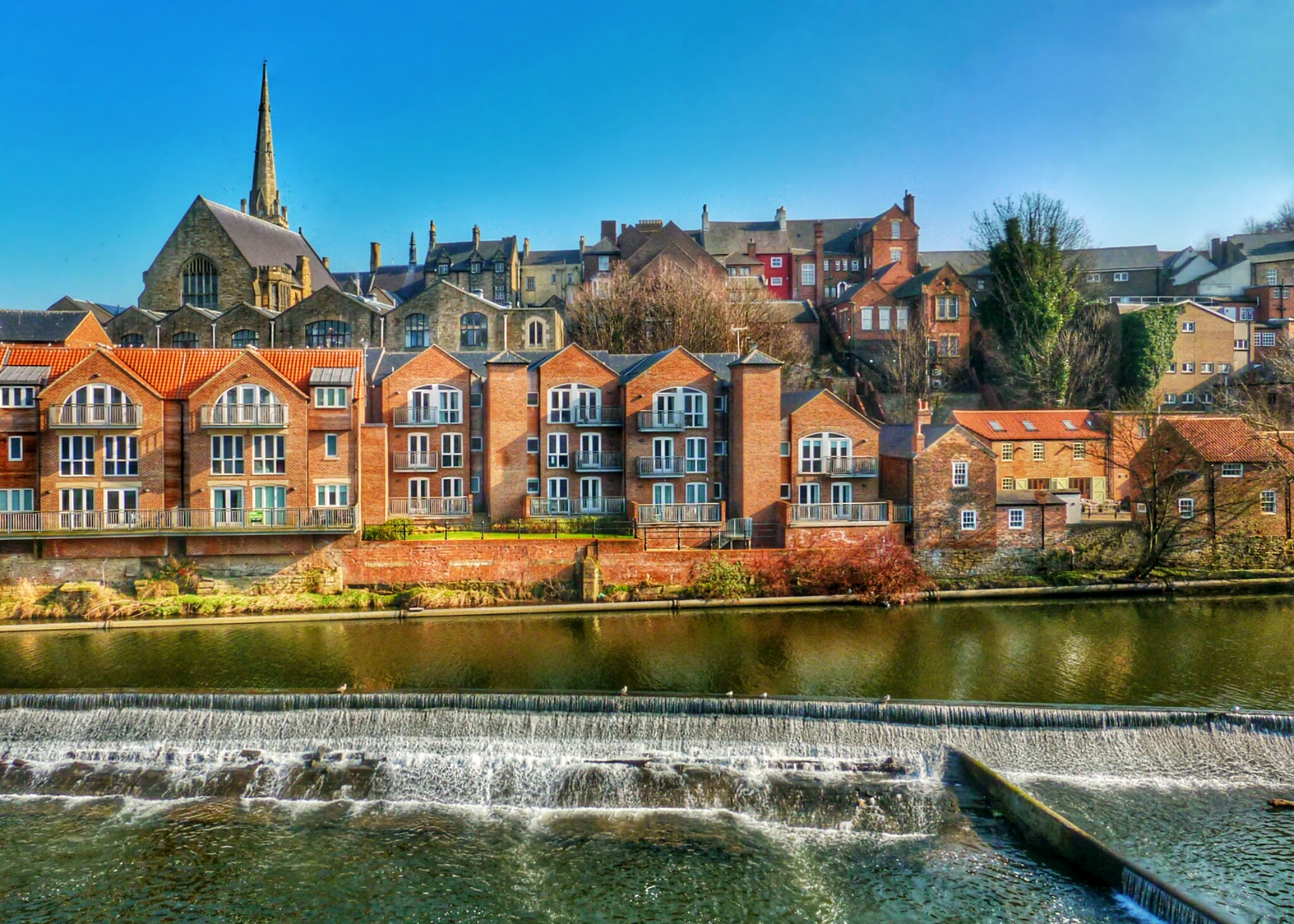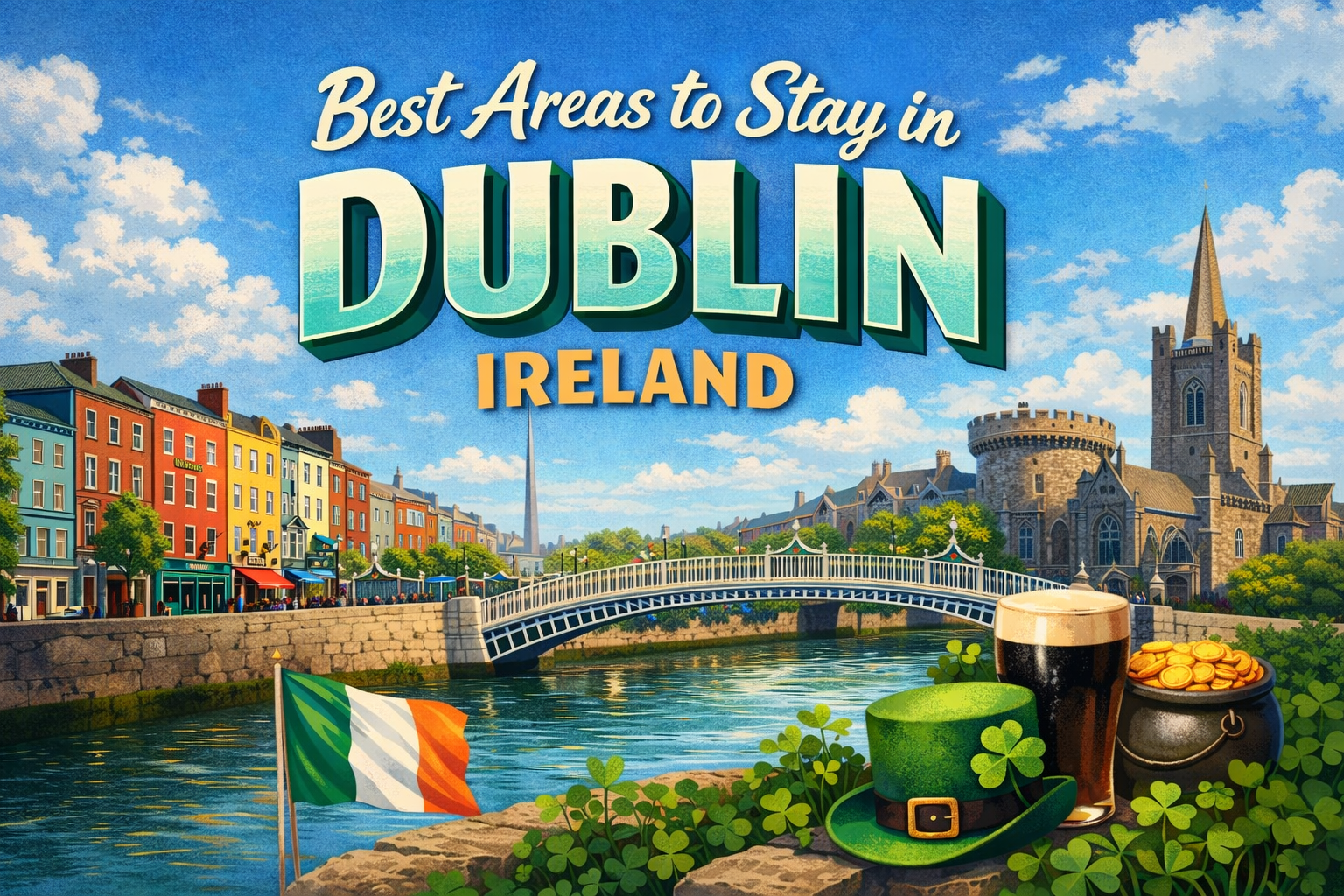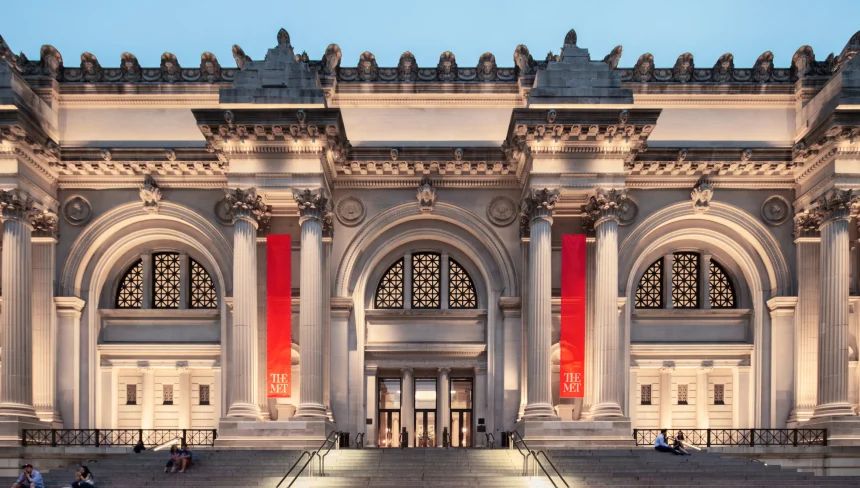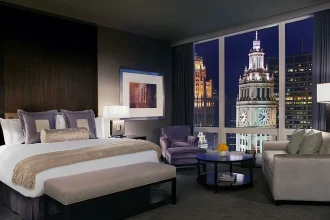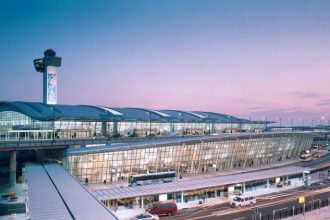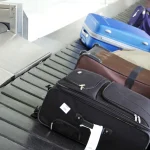Metropolitan Museum of Art, is the largest art museum in the United States. The world-famous museum is located at 82nd Street on Fifth Avenue in New York. The Metropolitan Museum of Art traces the development of the history of mankind’s own civilization. Along with the Forbidden City in Beijing, China, the British Museum in London, England, the Louvre in Paris, France, and the Hermitage Museum in St. Petersburg, Russia. It is known as one of the world’s five greatest museums. The Metropolitan Museum of Art is a sprawling building on Fifth Avenu in New York City. It contains five major galleries for European paintings, American paintings, primitive art, medieval paintings and Egyptian antiquities. There are a total of 248 showrooms. And the tens of thousands of exhibits on display year-round.
Exhibitions Distribution
The Metropolitan Museum of Art has 3 floors of exhibition halls. Divided into Costume, Greco-Roman Art, Primitive Art, Weapons and Armor, European Sculpture and Decorative Arts, and American Art. As well as 18 showrooms and exhibition rooms for the R. Lyman Collection, Ancient Near Eastern Art, Medieval Art, Far Eastern Art, Islamic Art, 19th Century European Paintings and Sculpture, Prints, Drawings and Photographs, 20th Century Art, European Paintings, Musical Instruments, and Temporary Exhibitions. The Costume Showroom was developed from the original Museum of Costume Art. It was incorporated into the Metropolitan Museum of Art in 1946 and became a separate department with a collection. The collections include more than 10,000 costumes from around the world. The timeline from the 17th to the 20th centuries. As well as a library and a design room for researchers specializing in costume design.
Culture Relics
The Metropolitan Museum of Art has a collection of more than 3.3 million art treasures from all parts of Egypt, Babylon, Assyria, the Far and Near East, Greece and Rome, Europe, Africa, the pre-Columbian Americas, and New Guinea. They include architecture, sculpture, paintings, drawings, prints, photographs, glassware, ceramics, textiles, metalwork, furniture, ancient houses, weapons, armor and musical instruments from all periods of history, both ancient and modern.
The museum exhibits not only paintings and sculptures, but also tapestries, musical instruments, costumes, and decorative objects. The five main galleries are: European Paintings, American Paintings, Primitive Art, Medieval Paintings, and Egyptian Antiques.
Metropolitan Museum of Art Info
Contact Phone: (212) 535-7710
Opening hours: Closed on Wednesdays, Sunday-Tuesday/Thursday: 10am – 5pm, Friday/Saturday: 10am – 9pm
Tour time: 3 hours to 1 day
View Address: 1000 Fifth Avenue at 82nd Street New York, NY 10028 , located in the neighborhood of New York’s Central Park.

Branches
The Met Breuer Branch of the Metropolitan Museum of Art
The Met Breuer also known as the Gardens. It serves as a complementary pavilion to the Metropolitan Museum of Art. It displaying contemporaneous works of art spanning the breadth and history of the globe. If you purchase a Metropolitan Museum of Art ticket. You can visit the Gardens for free on the day of your ticket. So it’s up to you to choose whether or not to go.
Address: 945 Madison Ave, New York,NY 10021
The Met Branch Abbey Museum
The Met Cloisters, The Abbey Museum, a branch of the Metropolitan Museum of Art, is often overlooked by travelers. The Abbey Museum is the only museum in the United States that exhibits only medieval European art. In medieval Europe, the sacred and the secular existed side by side. Glory and darkness coexisted, and art reached a certain kind of extreme with religious exuberance.
Address: 99 Margaret Corbin Dr, NewYork, NY 10040
Transportations
Subway and Bus
- From East Manhattan : By Subway : Please take the 4, 5 or 6 subway lines to 86th Street and walk three blocks west to Fifth Avenue. This stretch is approximately 800 meters long, so expect a 10-minute walk. By Bus : Take the M1, M2, M3 or M4 buses along Fifth Avenue (from Uptown) to 82nd Street or along Madison Avenue (from Downtown) to 83rd Street.
- Start from Manhattan West : Take the 1 subway to 86th Street and transfer to the M86 bus from Central Park to Fifth Avenue. Or take the C subway to 81st Street and transfer to the M79 bus from Central Park to Fifth Avenue.
- Penn Station : Take the M4 bus to 83rd Street and Madison Avenue. Or take the C subway to 81st Street and transfer to the M79 bus through Central Park to Fifth Avenue.
- From the Metropolitan Museum of Art Abbey: Take the M4 bus directly to 82nd Street and Fifth Avenue. Or you can take the A subway to 125th Street, transfer to the B or C subway, get off at 81st Street.And then transfer to the M79 bus, which will take you across Central Park to Fifth Avenue.
Sightseeing Bus
Gray Line New York Sightseeing Tours and CitySights NY Bus Tours: Uptown Grand Circle, stop 35.
By Car
The Abbey Branch of the Metropolitan Museum of Art. Northern New Jersey and New England : Take the southbound Henry Hudson Parkway to the 96th Street exit. Cross Central Park and turn right on Fifth Avenue; enter the museum parking garage at 80th Street.
Brooklyn and Staten Island : Northbound/Uptown FDR Drive via Williamsburg Bridge, Manhattan Bridge, Brooklyn Bridge, or Battery Tunnel. And exit at 96th Street. Go straight to York Avenue. Turn right on 86th Street; turn left on Fifth Avenue; enter the Museum Parking Garage at 80th Street.
New Jersey South : From New Jersey Turnpike to Holland Tunnel-Uptown exit. North on Hudson Street becomes Eighth Avenue, which then becomes Central Park West; at 86th Street, turn right and go through Central Park; turn right on Fifth Avenue into the Museum Parking Garage at 80th Street.
Bronx, Queens, Upstate New York and New England via the Kennedy Bridge: Enter southbound/downtown bound FDR Drive to 96th Street exit. Go straight to York Avenue. Turn right at 86th Street; turn left at Fifth Avenue into the Museum Parking Garage at 80th Street.
Queens and Long Island via the Queensboro Bridge: Use any level of the bridge. Take the 60th Street exit in the right lane. Turn right on Madison Avenue heading north/uptown. And turn left on 81st Street, then left on Fifth Avenue; enter the Museum Parking Garage at 80th Street.
Metropolitan Museum of Art Tickets
| Tickets | Prices($dollars) |
|---|---|
| Adults | $30 |
| Seniors | $22 |
| Students | $17 |
| Membership and Children under 12 | Free |
| Caregivers accompanying disabled visitors | Free |
How to purchase tickets
The Metropolitan Museum of Art tickets can be bought on the official website, third-party platforms and on-site. The disadvantage of the official website is that it is written in English, and on-site there is the risk of not being able to buy the tickets when they are sold out, and sometimes you need to queue up, so basically, nowadays, with the advanced Internet, we are all directly on the third-party platforms (Klook, KKDAY) to buy, and it’s most convenient to go on the third-party platforms that legally sell tickets.
Official Online Purchase
Metropolitan Museum of Art official website
The guide to the Metropolitan Museum of Art
Main museum tour route suggested
The MET Fifth Avenue Main Pavilion exhibits are located on the 1st and 2nd floors. On the first floor, proceed counterclockwise through the soaring arches of The Great Hall to Egyptian Art on the right. The American Wing → Arms and Armor → Medieval Art → European Sculpture and Decorative Arts → Modern and Contemporary Art → Africa, Africa, and the Middle Ages. Contemporary Art → Arts of Africa, Oceania, and the Americas → Greek and Roman Art.
Then go up to the second floor. From our China as the representative of Asian art to continue to visit counterclockwise. Through Asian Art → The American Wing → European Paintings → Photographs → 19th and Early 20th Century European Paintings and Sculpture → Art of Arab Lands, Turkey, Iran, Central Asia, and Later South Asia. 19th and Early 20th Century European Paintings and Sculpture → Art of Arab Lands, Turkey, Iran, Central Asia, and Later South Asia → Art of the Ancient Near East → Art of the Ancient Near East → The American Wing → European Paintings → Photographs → 19th and Early 20th Century European Paintings and Sculpture Art of Arab Lands, Turkey, Iran, Central Asia, and Later South Asia → Ancient Near Eastern Art, and finally the store on the first floor to see if you have a favorite souvenir to take home.
Must-see galleries at the Metropolitan Museum of Art
The Greek and Roman Sculpture Court | Gallery 162: A hall filled with ancient Greek sculptures.
The Vermeer Collection | Gallery 632: A gallery of works by 17th century Dutch painter Johannes Vermeer.
Asian Art Collection | Start in Gallery 206: The Asian Art section, with a large number of valuable Chinese artifacts. In addition to the panoramic display of Suzhou Garden, the most famous exhibit is the Yuan Dynasty Medicine Buddha mural.
An Impressionist Treasury | Gallery 826: A gallery of European paintings from the 19th and early 20th centuries. The painting include Van Gogh’s works.
The Temple of Dendur | Gallery 131: The only Egyptian temple in the Western Hemisphere. Cut up and shipped to the United States.
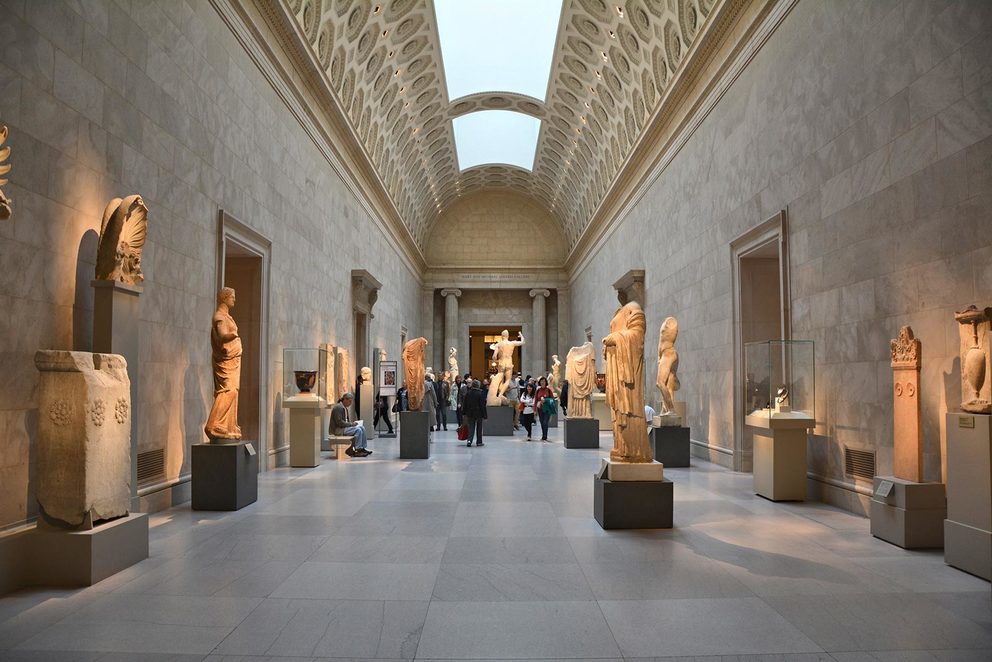
Treasures of the Metropolitan Museum of Art
Temple of Dendur
The Temple of Dendur, the museum’s largest town treasure. It also known as the Temple of Dendur, a gift from the Egyptian government to the United States. Which is the only complete ancient Egyptian temple outside of Egypt. The temple is divided into two parts, front and back. And until now, the temple’s column capitals, writing on the walls, reliefs and other details are well preserved. The upper part and one side of the large exhibition hall are full of glass curtain walls. So that the temple see the sunrise at night, sunset at night, with the moonlight and starlight at night. As in Egypt itself, and the world as one. Beyond the glass walls are the lush trees of Central Park. In the middle of which stands the only ancient Egyptian obelisk in the Americas.
The Dance Class
One of the more iconic of Edgar Degas’s paintings of ballet dancers. It created in 1874. There are so many figures in The Dance Studio that Degas deliberately placed the large mirror of the rehearsal hall in the center of the picture to enhance the sense of space. In the midst of a dozen or so young girls stands a white-haired elder on crutches, reviewing a young girl’s performance. Looking closely at the picture. The young girl’s movements are different, and Degas’s grasp of the character’s gestures is evident in the moment. This is the Paris dance classroom ballet examination scene. Degas has never been to such an examination room, just according to the legend painted this tense and complicated scene.
Kanagawa Surf Map
Japanese ukiyo-e artist Katsushika Hokusai’s representative work “Thirty-six Views of Fuyake” in a pair. Hokusai was a master of ukiyo-e during the Edo period in Japan. Many European Impressionist and Post-Impressionist painters such as Van Gogh, Monet and Gauguin copied his works. The picture depicts a fishing boat swept by huge waves, and the heroic boatmen are in a thrilling and fierce battle with nature for survival. Mt. Fuji is in the distance, creating an atmosphere of turmoil and tension.
Washington Crossing the Delaware
Washington Crossing the Delaware is an oil painting by German artist Emmanuel Loiz in 1851. It depicts Washington crossing the Delaware River on December 25, 1776, during the American Revolutionary War. This raid against Hessian mercenaries was the first step in the Battle of Trenton. And in 2004, the work became part of the permanent collection of the Metropolitan Museum of Art. There are many copies of the work. One of which hangs in the West Wing reception area of the White House.
Euphronios Krater
Euphronios Krater, Ancient Greek antique. It was 2,500 year old, beautifully ornate patterned pottery vase used to hold water and wine. The vase is a red painted terracotta with an opaque black non-slip ceramic clay background. The pottery vase is decorated with two scenes. The image of the Trojan War is shown on the obverse side. It depicts the deaths of Sarpedon, Zeus, and Laodamia. The reverse side of the vase shows the youth of Athens at the time arming themselves for battle from before the 6th century B.C.. The vase is decorated with two scenes. Although the picture of the death of Sarpedon is one that usually depicts programmed performances in antiquity. What is depicted in this scene is naturalistic.
Must-see collections
1. King Henry VIII’s Armor
Game of Thrones fans are in for a treat at the Weapons and Armor gallery. Which displays a number of swords, spears and armor. The collection contains the largest collection of 16th and 17th century European armor in the country. It including two suits of armor from King Henry VIII of England. One worn when he was healthy enough to go to war. And the other used during the final stages of his life. There is also an excellent collection of Japanese samurai artifacts. It including an Edo period armor (goujou) with the signature inscription Saotome Iyetada on the helmet.
Location: First Floor, Gallery 371
2. Chinese Buddhist Sculpture
The Met’s Chinese Buddhist Sculpture is home to the largest, most comprehensive, and finest collection of Asian art in the continental United States. If not the entire West, and is located in the Asian Art Gallery. You can see majestic sculptures made of stone, bronze, wood and clay. The bodhisattvas of two stand out. The Guanyin Avalokiteshvara (Guanyin), a 14-foot-tall sandstone sculpture from 550-560 A.D.. With traces of paint and Buddha still visible, and the Amitabha, from the early 7th century. Despite their great antiquity, they are still intact and present the styles of that era in their original form.
Location: 2nd floor, galleries 206 and 208
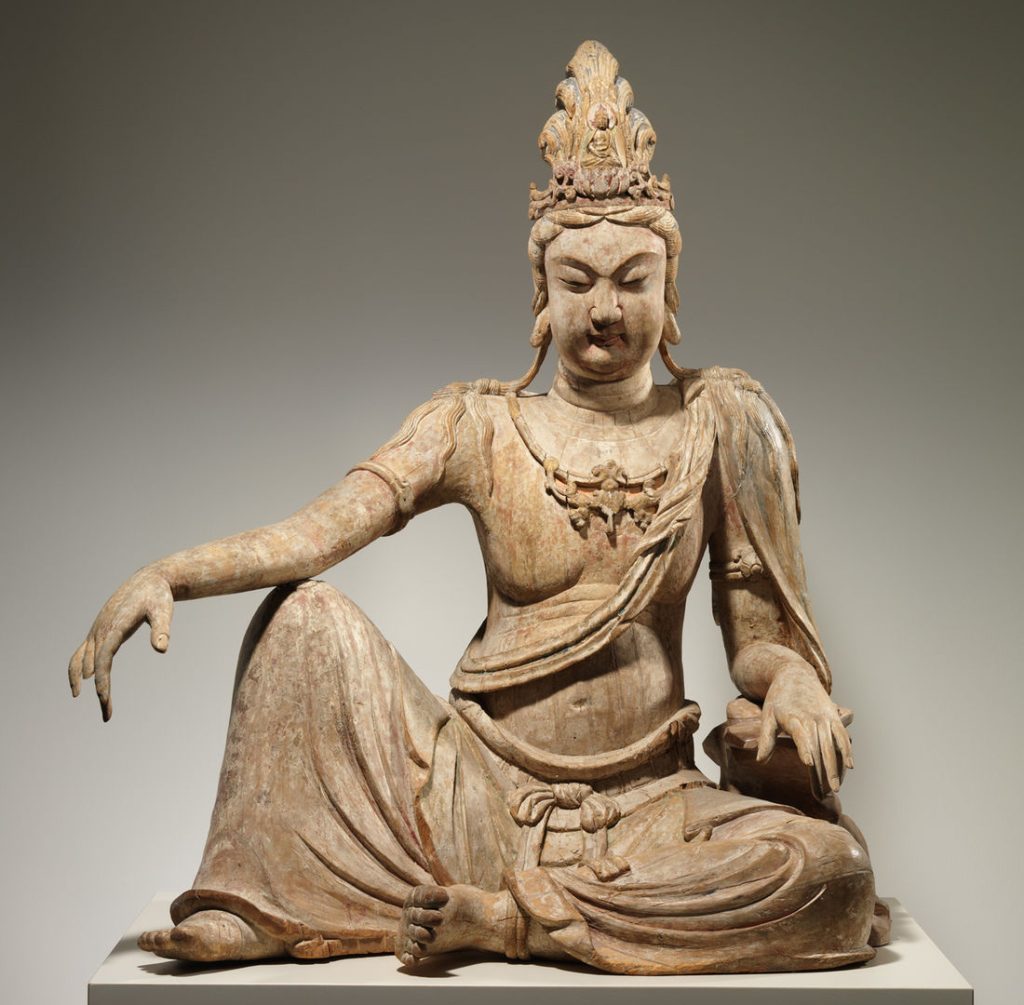
3. Modern and Contemporary Art
The Metropolitan Museum of Art is sometimes criticized for not giving enough attention to contemporary art. But there’s actually quite a bit of modern art inside the galleries. The art such as Autumn Rhythm (No. 30), a huge painting by Jackson Pollock, which is displayed in Gallery 901. And a stroll back up the stairwell will take you to Gallery 915, located on the mezzanine level of the massive staircase. Where you can lounge on the benches over there while admiring the various collections.
Location: Gallery 915
4. Wheat Field with Cypresses
Despite his tortured life, 19th-century artist Vincent van Gogh’s compelling paintings have endured the test of time and have been immortalized. Van Gogh’s paintings have a kind of magic that makes people can’t take their eyes off of them. The curling lines of “Silk Cypress Trees in a Wheat Field” (1889). It seem to be like a whirlpool that people can’t help themselves from. It is said to be one of his favorite paintings in the series. Also on the list of must-see paintings is Johannes Vermeer’s Young Woman with a Water Pitcher.
Location: Second Floor, Gallery 823
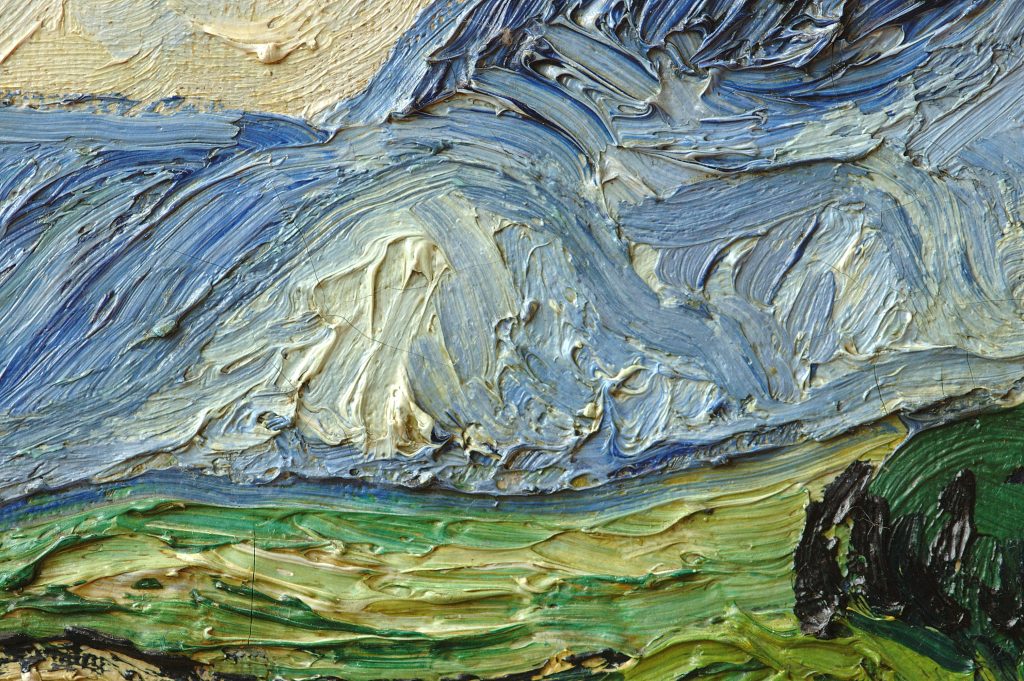
5. Perseus with the Head of Medusa
The European Sculpture Gallery showcases a variety of extraordinary works of art. And Perseus and the Head of Medusa (1804-1806) is a must-see. The original sculpture, located in the Vatican, was created at the request of a Polish countess, and although it’s a replica, the lines are said to be smoother than in the original, and the 8-foot-tall nude Perseus holding the head of Medusa’s serpent is just as eye-catching. Note: Fans of marble sculpture should also not miss Ugolino and his Sons by Jean-Baptiste Carpeaux.
Venue: Ground floor, gallery 548
6. Winged Bull
One of the iconic collections of the Metropolitan Museum of Art. The human-headed winged bull and winged lion are displayed together at the entrance to Gallery 401. Together they guarded the palace of the Assyrian king in the 9th century BC.
Location: Gallery 401
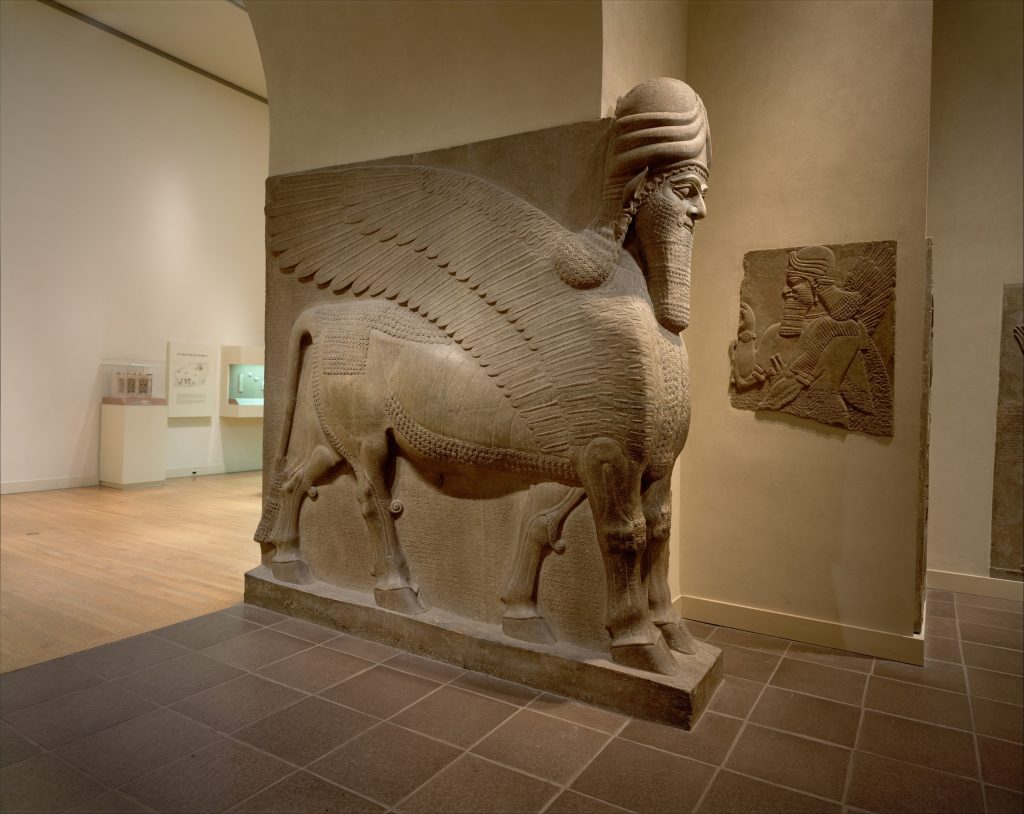
7. The Astor Chinese Garden Court
The Astor Courtyard, located in the Asian Art Gallery. It is a small but sophisticated place for meditation. Modeled after a 17th-century Chinese courtyard, it borrows from traditional tools and styles, with rockeries, ponds and rare nanmu trees, and an adjacent reception room decorated with hardwood furniture from the Ming Dynasty. Walking into this place is like entering another world. After spending too much time in the crowded crowd, come here for a short break to recharge your batteries.
Location: Second Floor, Gallery 217
8. Islamic Art
The works in these galleries illustrate the history of the Arabian Peninsula, Turkey, Central and South Asia. Where one can experience the clash of civilizations and differences between them. For something a little different, head to Gallery 461. Where the interior design is a complete recreation of 18th century Ottoman Empire décor, known as the Damascus Room.
Location: Gallery 461
9. Jain Temple
In Gallery 243, admire the intricately carved wooden dome and balcony that was part of a 16th century Jain temple in Gujarat, India. You can take some time to study it properly.
Location: Gallery 243
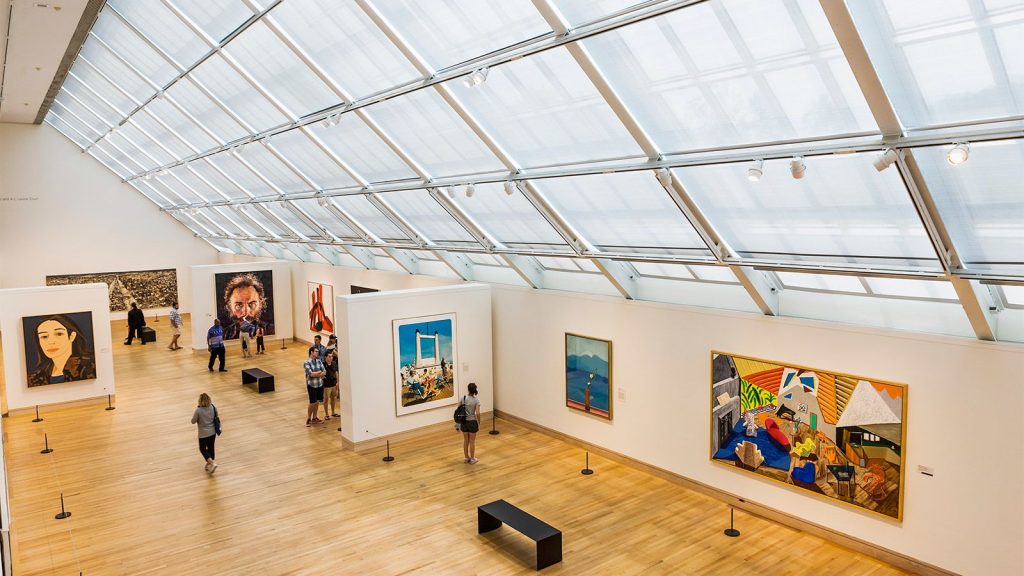
Special Activities in the Museum
1. Tour activities with a guide
This type of activity usually has a clear theme, some are to take you a quick look at the most famous museum where the essence. Some are for a particular pavilion for a detailed introduction. There are also special tours themed on content, such as music and art themed tours. Some experts will even be invited to speak with the audience on a particular work of art.
2. Making art under the guidance of artists
In the Metropolitan Museum of Art so a full of art atmosphere. You will be guided by an artist to create a piece of artwork of your own. There is a workshop in the basement of the museum dedicated to visitors. However, due to conditions, this program requires advance registration and payment.
3. Sunday Workshop
Every Sunday from 1pm to 4pm. The Metropolitan Museum of Art selects a number of different art forms and offers free on-site creation activities for visitors. Unlike the high-end teaching activities mentioned above, this is open to all.
4. Live copying and painting
We often see artists or enthusiasts copying in front of artworks in art museums. This kind of professional copying is required to apply in advance.
5. Lectures and Talks
Like the TED Talks, the Metropolitan Museum of Art regularly conducts lectures or symposiums on art, archaeology, and other topics. Sometimes experts are invited to give special lectures, and sometimes the museum’s researchers regularly share their recent findings.
6. Live Art Performances
The Metropolitan Museum of Art not only satisfies the desire to appreciate the artwork aspect, but also invites artists to create live artworks so that the audience can witness for themselves how the artworks are created. These works of art are sometimes paintings, sculptures, and sometimes music and other aural pleasures. On the first floor of the museum, next to the Egyptian Art Gallery, there is a small theater with a capacity of 700 people, which is used by the museum to hold musical or theatrical performances.
Hotels Near Metropolitan Museum of Art
If you’re a museum person and love Central Park, you might want to stay nearby! Below are recommendations for hotels near the Metropolitan Museum of Art within a 10-minute walk and with good reviews:
- The Mark New York
- The Surrey
- Hotel Beacon
- The Wallace (The Millburn Hotel)
Want to find a house in New York?
If you are looking for a house rent in USA, uhomes is a good choice for you to choose apartment to live in New York, Los Angeles, Chicago, San Fransisco. There are different types of house for you to rent. And you can fill in a form. There will our consultant contact with you soon. When you first arrive in USA, you need to have a check list to have a full checking about your new house.
Restaurants Near Metropolitan Museum of Art

The Metropolitan Museum of Art has several restaurants, the following are good value for money:
When you’re hungry, head to The Cafeteria on the Ground Floor for inexpensive full meals.
For afternoon tea, check out The Petrie Court Café.
In summer, head to The Cantor Roof Garden Bar.
Since you can re-enter on the same day with a single ticket, it’s a good idea to have a picnic in the park and come back.
Tips
- Food and beverages other than plastic bottled water are not permitted inside the Metropolitan Museum of Art.
- Cameras and flashes are not permitted inside the museum. Tripods are permitted Monday through Friday and require a permit at the front desk in the lobby.
- No pens other than pencils are permitted in the museum.
- Baby strollers and wheelchairs are allowed on the premises.
- Large luggage and boarding boxes are not allowed to be brought into the museum and are not available for storage. It is recommended that you do not bring your luggage to the museum and do not carry your school bag in the museum.
- If you need to charge your cell phone, you can go to the first floor lobby. It can accommodate a large number of visitors. There are few charging outlets elsewhere in the museum.
FAQ
Members and patrons enjoy free and unlimited entry. And complimentary admission is provided for children under 12 and caregivers accompanying a visitor with a disability. However, general admission tickets cost $30 for adults, $22 for seniors, and $17 for students.
The Metropolitan Museum of Art, affectionately known as The Met, is a treasure trove of some of the world’s most famous and awe-inspiring pieces of art. Among its many highlights are well-known paintings such as “Julie Le Brun Looking in a Mirror,” “Washington Crossing the Delaware,” and “The Death of Socrates”.
The Metropolitan Museum of Art, is indeed one of the world’s largest and finest art museums. It boasts an expansive floor space and a collection that spans 5,000 years of world culture. From prehistoric times to the present. However, in terms of size, the Louvre in Paris holds the title for the biggest art museum in the world.
The Metropolitan Museum of Art has been a beacon of culture and education. It’s not just a museum. But an institution that symbolizes the power of human creativity and the strength of the human spirit. From classical Renaissance art to medieval armor, from Roman and Greek sculptures to priceless works by Vermeer, The Met offers an unparalleled journey through time and across cultures.
The best time to visit The Met is first thing in the morning when they open. There are generally fewer visitors in the morning, and the museum tends to get busier as the day progresses. If you’re considering which days to visit, weekdays are generally quieter. Specifically, Wednesday and Thursday mornings are recommended for the least amount of crowds.
On average, visitors typically spend around 2-3 hours at the museum. This allows time to explore the various galleries and exhibitions at a leisurely pace. However, if you’re particularly interested in modern and contemporary art. You may choose to stay one day to fully immerse yourself in the art.
Savoring Sweetness: An Exploration of Milk Tea in USA
For those of you who are studying or working in USA, milk…
USA Hotels Guide for Check-In and Check-Out Process
When you study aboard in the United States , the best way…
JFK Airport Duty Free Shop Handbook for the Travelers
During the waiting time for a flight, people choose to browse the…
